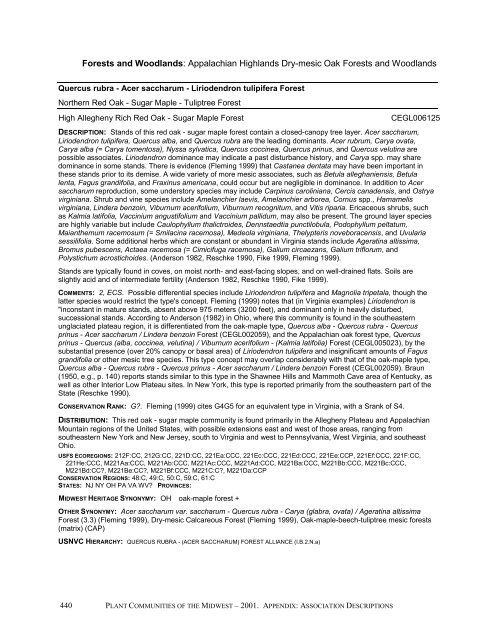Ohio subset of Plant Communities of the Midwest ... - NatureServe
Ohio subset of Plant Communities of the Midwest ... - NatureServe
Ohio subset of Plant Communities of the Midwest ... - NatureServe
You also want an ePaper? Increase the reach of your titles
YUMPU automatically turns print PDFs into web optimized ePapers that Google loves.
Forests and Woodlands: Appalachian Highlands Dry-mesic Oak Forests and Woodlands<br />
Quercus rubra - Acer saccharum - Liriodendron tulipifera Forest<br />
Nor<strong>the</strong>rn Red Oak - Sugar Maple - Tuliptree Forest<br />
High Allegheny Rich Red Oak - Sugar Maple Forest<br />
CEGL006125<br />
DESCRIPTION: Stands <strong>of</strong> this red oak - sugar maple forest contain a closed-canopy tree layer. Acer saccharum,<br />
Liriodendron tulipifera, Quercus alba, and Quercus rubra are <strong>the</strong> leading dominants. Acer rubrum, Carya ovata,<br />
Carya alba (= Carya tomentosa), Nyssa sylvatica, Quercus coccinea, Quercus prinus, and Quercus velutina are<br />
possible associates. Liriodendron dominance may indicate a past disturbance history, and Carya spp. may share<br />
dominance in some stands. There is evidence (Fleming 1999) that Castanea dentata may have been important in<br />
<strong>the</strong>se stands prior to its demise. A wide variety <strong>of</strong> more mesic associates, such as Betula alleghaniensis, Betula<br />
lenta, Fagus grandifolia, and Fraxinus americana, could occur but are negligible in dominance. In addition to Acer<br />
saccharum reproduction, some understory species may include Carpinus caroliniana, Cercis canadensis, and Ostrya<br />
virginiana. Shrub and vine species include Amelanchier laevis, Amelanchier arborea, Cornus spp., Hamamelis<br />
virginiana, Lindera benzoin, Viburnum acerifolium, Viburnum recognitum, and Vitis riparia. Ericaceous shrubs, such<br />
as Kalmia latifolia, Vaccinium angustifolium and Vaccinium pallidum, may also be present. The ground layer species<br />
are highly variable but include Caulophyllum thalictroides, Dennstaedtia punctilobula, Podophyllum peltatum,<br />
Maian<strong>the</strong>mum racemosum (= Smilacina racemosa), Medeola virginiana, Thelypteris noveboracensis, and Uvularia<br />
sessilifolia. Some additional herbs which are constant or abundant in Virginia stands include Ageratina altissima,<br />
Bromus pubescens, Actaea racemosa (= Cimicifuga racemosa), Galium circaezans, Galium triflorum, and<br />
Polystichum acrostichoides. (Anderson 1982, Reschke 1990, Fike 1999, Fleming 1999).<br />
Stands are typically found in coves, on moist north- and east-facing slopes, and on well-drained flats. Soils are<br />
slightly acid and <strong>of</strong> intermediate fertility (Anderson 1982, Reschke 1990, Fike 1999).<br />
COMMENTS: 2, ECS. Possible differential species include Liriodendron tulipifera and Magnolia tripetala, though <strong>the</strong><br />
latter species would restrict <strong>the</strong> type's concept. Fleming (1999) notes that (in Virginia examples) Liriodendron is<br />
"inconstant in mature stands, absent above 975 meters (3200 feet), and dominant only in heavily disturbed,<br />
successional stands. According to Anderson (1982) in <strong>Ohio</strong>, where this community is found in <strong>the</strong> sou<strong>the</strong>astern<br />
unglaciated plateau region, it is differentiated from <strong>the</strong> oak-maple type, Quercus alba - Quercus rubra - Quercus<br />
prinus - Acer saccharum / Lindera benzoin Forest (CEGL002059), and <strong>the</strong> Appalachian oak forest type, Quercus<br />
prinus - Quercus (alba, coccinea, velutina) / Viburnum acerifolium - (Kalmia latifolia) Forest (CEGL005023), by <strong>the</strong><br />
substantial presence (over 20% canopy or basal area) <strong>of</strong> Liriodendron tulipifera and insignificant amounts <strong>of</strong> Fagus<br />
grandifolia or o<strong>the</strong>r mesic tree species. This type concept may overlap considerably with that <strong>of</strong> <strong>the</strong> oak-maple type,<br />
Quercus alba - Quercus rubra - Quercus prinus - Acer saccharum / Lindera benzoin Forest (CEGL002059). Braun<br />
(1950, e.g., p. 140) reports stands similar to this type in <strong>the</strong> Shawnee Hills and Mammoth Cave area <strong>of</strong> Kentucky, as<br />
well as o<strong>the</strong>r Interior Low Plateau sites. In New York, this type is reported primarily from <strong>the</strong> sou<strong>the</strong>astern part <strong>of</strong> <strong>the</strong><br />
State (Reschke 1990).<br />
CONSERVATION RANK: G. Fleming (1999) cites G4G5 for an equivalent type in Virginia, with a Srank <strong>of</strong> S4.<br />
DISTRIBUTION: This red oak - sugar maple community is found primarily in <strong>the</strong> Allegheny Plateau and Appalachian<br />
Mountain regions <strong>of</strong> <strong>the</strong> United States, with possible extensions east and west <strong>of</strong> those areas, ranging from<br />
sou<strong>the</strong>astern New York and New Jersey, south to Virginia and west to Pennsylvania, West Virginia, and sou<strong>the</strong>ast<br />
<strong>Ohio</strong>.<br />
USFS ECOREGIONS: 212F:CC, 212G:CC, 221D:CC, 221Ea:CCC, 221Ec:CCC, 221Ed:CCC, 221Ee:CCP, 221Ef:CCC, 221F:CC,<br />
221He:CCC, M221Aa:CCC, M221Ab:CCC, M221Ac:CCC, M221Ad:CCC, M221Ba:CCC, M221Bb:CCC, M221Bc:CCC,<br />
M221Bd:CC, M221Be:CC, M221Bf:CCC, M221C:C, M221Da:CCP<br />
CONSERVATION REGIONS: 48:C, 49:C, 50:C, 59:C, 61:C<br />
STATES: NJ NY OH PA VA WV PROVINCES:<br />
MIDWEST HERITAGE SYNONYMY: OH oak-maple forest +<br />
OTHER SYNONYMY: Acer saccharum var. saccharum - Quercus rubra - Carya (glabra, ovata) / Ageratina altissima<br />
Forest (3.3) (Fleming 1999), Dry-mesic Calcareous Forest (Fleming 1999), Oak-maple-beech-tuliptree mesic forests<br />
(matrix) (CAP)<br />
USNVC HIERARCHY: QUERCUS RUBRA - (ACER SACCHARUM) FOREST ALLIANCE (I.B.2.N.a)<br />
PLANT COMMUNITIES OF THE MIDWEST – 2001. APPENDIX: ASSOCIATION DESCRIPTIONS<br />
440
















